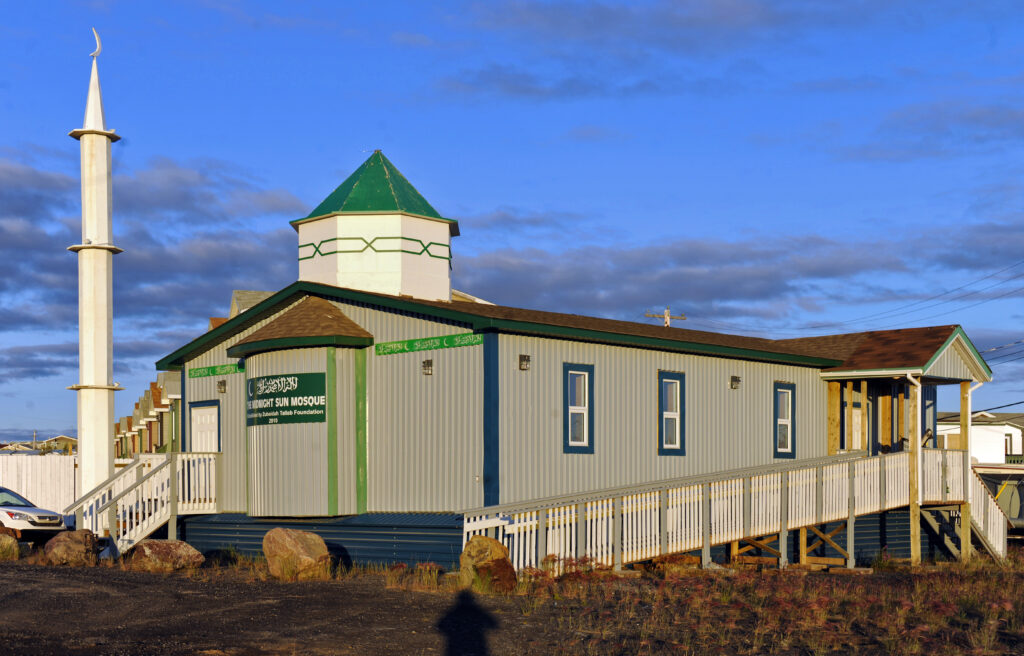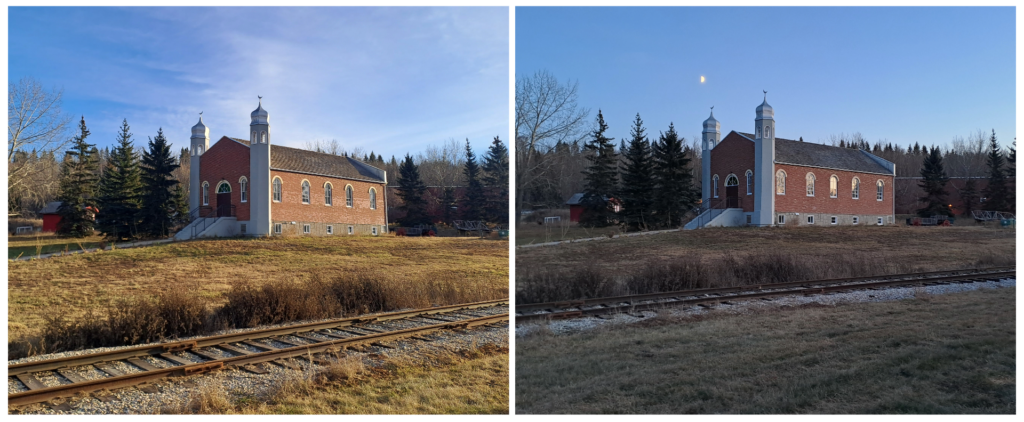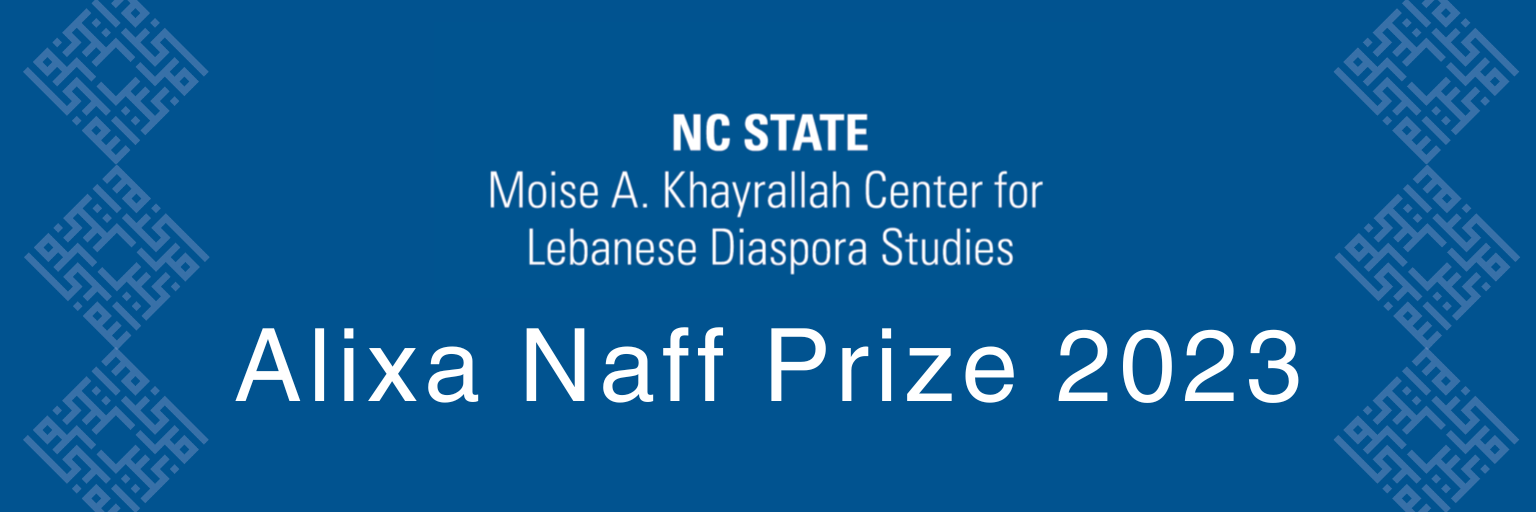Muslim Pioneers* in Canada’s North
How do Muslims live Islam in Arctic Canada, so distant from its cradle? How do they foster a sense of home and belonging in these distinctive surroundings that challenge their religious practice in manifold ways?
One such strategy of homemaking and rooting the community within its locality is the construction of mosques. In recent years, three purpose-built mosques have been erected in Northern Canada. In the case of the Midnight Sun Mosque the word “home” even applies in a literal sense, the only affordable way to build it was to have a prefab family home structure sent 4500 km (approximately 2800 miles) by truck and barge to Inuvik and have it turned into the northernmost mosque of the Western hemisphere. After it was built in Inuvik in 2010, Nunavut’s first mosque followed in Iqaluit in 2016, and Yukon’s first mosque in Whitehorse in 2018. The Islamic Center in Yellowknife is still under construction as of 2023.

The study summarized here forms part of my Ph.D. project and belongs to a larger research initiative titled, The Arctic Muslim. Guided by the concept of lived religion [1], its aim is to take the study of modern Muslim subjectivities into a new geographical direction. Looking at aspects such as sacred time, qibla orientation, and mosque design, we learn how the small but utterly diverse communities navigate their ethnic, religious, and cultural differences when it comes to practical, legal, and spiritual matters in the distinctive Arctic environment. This is further complicated by matters of indigeneity and the entanglement between settler-colonial, Indigenous, and newcomer identities, as well as the economic, ecological, and political implications of so-called “resource extractivism,” climate change, and the repercussions of global conflicts that reflect on Arctic communities.
The Muslim communities of today were not the first to settle in the far north on the North American continent. The first Arab pioneers were Muslims, Christians, and Druze from present-day Lebanon, and they arrived in Canada in the second half of the 19th century. Their history – eventually leading to the construction of Canada’s first mosque, Al Rashid in Edmonton, Canada’s “Gate to the North,” in 1938 – offers a valuable point of reference when looking at the ways in which Muslims in the Arctic today organize themselves and build mosques.

Among the first recorded Muslims in Alberta and the first hundreds of Muslims who set foot on Canadian soil were 12-year-old Ali Abouchadi and his uncle Sine Kassim Chadi. The pair arrived in Winnipeg in 1905 and went on to Edmonton in 1906. Back home in Lebanon, Sine had heard about the Klondike Gold Rush, but when they arrived to find out that the rush had dwindled, they went on to Edmonton to work as peddlers. Ali adopted the name Alex Hamilton and became involved in fur-trading. He eventually opened a store in Lac La Biche and married there.
Like Ali and Sine, many of the early pioneers started their career peddling in the prairies of Manitoba, Saskatchewan, and Alberta. Over the years, they were able to expand their business activities from horseback transportation to opening general and convenience stores. Others became fur traders, started operating mink farms, or established trading posts in the north and learned the skills of trapping from the local Indigenous tribes [2]. One of them was Peter Baker who became later known as the Arctic Arab [3]. Baker arrived in Alberta as Bedouin Farran from Lebanon in 1910 and spent most of his life working as a trapper and fur trader in the north, in close contact with Indigenous communities whose languages he learned [4]. He later became one of the first Muslim politicians in Canada, serving the North-West Territories (NWT) Council.
Many of the first Muslims who arrived in Canada were Arabs from Bilād ash-Shām, especially from the Beqaa Valley between present day Lebanon and Syria. Fleeing famine or military conscription or longing for economic prosperity, security, adventure, and attracted by the business opportunities that came with free land for homesteading, they strove for a successful life and showed a high readiness to adapt to challenging living and working conditions [5]. Some of them stayed as far north as Fort McMurray or Lac La Biche where they helped establish Muslim communities that continually grew until today. Others, who had occasionally visited Edmonton as a stopover on their way north, eventually returned for the professional and educational resources as well as the growing Arab and Muslim population. The more Muslims that arrived and settled permanently in Canada, the more followed, encouraged or even invited by friends and family members. Soon there were Arab-Muslim and Arab-Christian neighborhoods alongside the fabric of European settlers in Edmonton.

In the 1930s, Edmonton Muslims combined their efforts to raise funds and build a space where they could gather for occasions and celebrations and have a place of worship. Scholarship alludes to the instrumental contribution of Muslim women in the efforts to campaign for what became the Al Rashid Mosque. Earle Waugh specifically writes about Hilwie Hamdon, whose fundraising was valuable to the growing community, in addition to the support of other religious networks around Edmonton at the time [6].
The early mosque’s social role is clearly visible from its use for events such as suppers with traditional Arab food, interreligious marriages, Quran and Arabic classes for kids, and much more. In the following decades, the pioneering character of the Al Rashid community showed in many ways. Numerous individuals shaped the foundation and development of Canadian Muslim organizations such as the Canadian Council of Muslim Women (established in 1982) or the Muslim Youth Club (in 1984) or later the Arabic Bilingual School and the Edmonton Islamic Academy.
Not much research has been done so far on rural and/or northern experiences of Muslims in Canada. Most of the efforts have been led by committed members themselves who work to preserve the heritage of their communities by writing or contributing to special edition anniversary books and journals. One of them is Richard Awid. He is the son of Ahmed Awid, one of the first Muslims to come to Brandon (in 1901) and later to Edmonton. According to Awid, the stories are manifold and rich, but as of now, the information is rather scattered and not systematized. With my project, I aim to contribute to providing a more comprehensive and systematic overview about previous and ongoing research efforts and add insights from my fieldwork in Edmonton, Yellowknife, Inuvik, and possibly other places in Canada’s North.
For readers who are interested in learning more about the Muslim communities in Canada’s North, please follow my research through our website or contact me at bmos@sdu.dk.
*I am aware of the colonialist connotation that the word “pioneer” conveys, especially in the context of North American history. My intention here is to honor the voices of those affected by colonialism and therefore briefly recount the insights they offered me into this complex matter.
An interview partner from the Dene First Nation who reflected on the shared trauma that colonized people had to endure, pointed to the consequences of the colonizer’s hegemonic discourse in education: Indigenous Peoples in residential schools were taught colonialist perspectives on Muslim civilizations whereas Muslims and Arabs in the Middle East learned about Indigenous Peoples from the colonizer’s perspective. I adopted the term “pioneer” from publications by Muslim authors on the early Muslim history in Canada and from conversations with my Muslim interview partners. The term appeared as self-description for their early peers who left their homelands and established themselves successfully somewhere else. One of my interviewees pointed to the importance and wish to reclaim and use the word for Muslims in its non-colonialist meaning, the pioneer being a leading figure in (scientific) progress and advancement.
I might not always have accurate words and vocabulary, yet I hope that with a peaceful intention, curiosity, and transparency, I can contribute to a respectful discussion on the different perspectives that surround this matter.
Some further references for initial research are listed below:
Ammerman, Nancy (2020), Rethinking Religion.
Barras, Amelie; Selby, Jennifer A., and Melanie Adrian (2022), Producing Islam(s) in Canada. On Knowledge, Positionality, and Politics.
Gaber, Tammy (2022), Beyond the Divide.
Mouallem, Omar (2022), Praying to the West.
Mukhtar, Ismael Ibrahim (2021), Manitoba Muslims.
Snowangel Films (Saira and Nilufer Rahman) (2015): Arctic Mosque (documentary).
Waugh, Earle (2018), Al Rashid Mosque.
Sources
[1] Ammerman, Nancy (2020), Rethinking Religion.
[2] Awid, Richard, Community historian in conversation on November 12th, 2023 in Edmonton.
[3] Baker, Peter (1976), Memoirs of an Arctic Arab. The story of a Free-Trader in Northern Canada.
[4] Waugh, Earle (2018), Al Rashid Mosque. P. 13, P. 14.
[5] ibid. P. 12
[6] Waugh, Earle (2018) Al Rashid Mosque. P. 24, P. 53
[7] Barras, Selby, Adrian (2022), Producing Islam(s). P. 102, P. 103
- Categories:


